Thunbergia Grandiflora Blue Plant
Thunbergia grandiflora Blue, a specific variety of Thunbergia, may have varying care requirements. Generally, plant in well-draining soil with partial to full sun exposure. Water consistently and provide support for climbing. Pruning helps maintain a tidy appearance.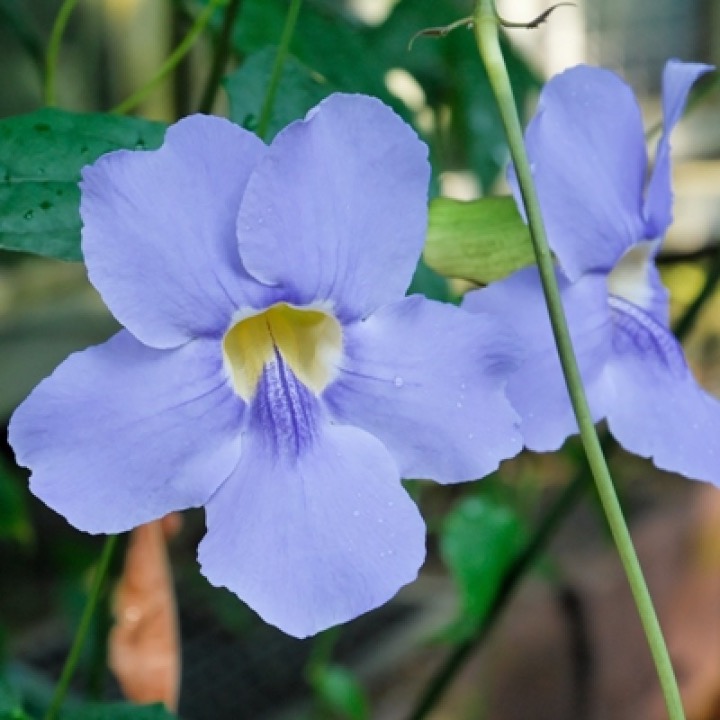
Habit
Climber
Height
3 to 5 m
Growth
Fast
Soil
Well-drained, Sandy Loam
Shade
Full Sun to partial shade
Moisture
Moist
Edible
No
Medicinal
No
Origin
India, Africa
Climatic Condition
Tropical, Subtropical
Temperature (°)
20°C to 30°C
Humidity (%)
60% to 80%
Potting media
50% Loam, 40% Sand, 10% Organic Matter
Fertilizers
Organic Fertilizer
Watering
Regular watering
Plant Weight
0.5 to 1.0 kg
Flowering Time
Spring to Summer
Soil Ph level
6.0 to 7.5
Water Ph level
6.0 to 7.0
Soil EC
0.5 to 0.8 mS/cm
Yield Per Plant
5 to 10 kg per plant
NPK ratio
10:20:10
life Span
3 to 5 years
Health Benefits
Ornamental, Medicinal
Suggested Grow Media or Potting Mix ?
40% peat moss, 30% compost, 30% perlite
Suggested Fertigation/Fertilizers
Fertilize every 2 weeks with a balanced, water-soluble fertilizer.
Common Diseases and Remedies
Brown spot.
Brown spots or patches to appear on the plant.
Neem oil
HEALTH BENEFITS
1. Antioxidant properties: Thunbergia grandiflora contains antioxidants that can help protect against oxidative stress and inflammation.
2. Anti-inflammatory effects: The plant's antioxidants and other compounds may help reduce inflammation and improve overall health.
3. May help improve cardiovascular health: Thunbergia grandiflora's antioxidants and other compounds may help improve cardiovascular health.
What is Thunbergia?
Thunbergia, commonly known as black-eyed Susan or clock vine, is a genus of flowering plants native to tropical regions of Africa, Madagascar, and South Asia. These fast-growing vines are popular in gardens and landscapes for their attractive trumpet-shaped flowers and ability to climb structures using twisted stems.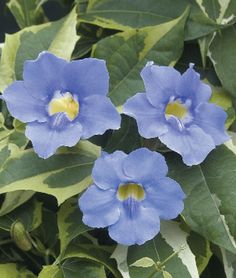
What types of Thunbergia are there?
There are several species and cultivars of the Thunbergia plant, each with its own unique characteristics. Popular species include:
1. *Thunbergia alata*
This species, also known as black-eyed Susan, is known for its showy flowers with dark centers and light petals. They come in a variety of colors, including orange, yellow, and white.
2. *Thunbergia grandiflora* –
This species is known as the Bengal clock vine and is characterized by large, showy flowers in shades of blue and purple. It is a powerful climber and can reach heights of up to 20 feet.
3. *Thunbergia erecta*
This species is also called bush clock vine and is more compact and bushy compared to other Thunbergia varieties. It produces clusters of white, yellow, and orange tubular flowers.
4. *Thunbergia mysorensis*
Commonly known as Mysore trumpet vine or Indian clock vine, this species is characterized by unusual drooping flowers that resemble small hanging baskets of red-yellow color.
5. *Thunbergia Fragrance*
This species, also known as Sweet O'Clock Vine, is prized for its clusters of fragrant white flowers. It is a relatively low-growing variety, making it suitable for hanging baskets and ground covers.
These are just a few examples of the variety of Thunbergia plants available to gardeners and plant enthusiasts. Each type has its own beauty and growth requirements. Therefore, it is important to choose the right variety for your garden or landscape.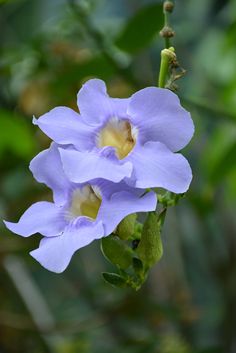
How do I care for my Thunbergia plant?
Location
Thunbergia plants grow in warm tropical or subtropical climates. Prefers full sun and well-drained soil rather than partial shade. In cooler climates, it can be grown as an annual or in containers that can be brought indoors during the colder months. It is important to provide support for climbing plants, as they grow very vigorously and may need something to climb on, such as a trellis or fence. Thunbergia plants are relatively easy to care for and can tolerate a variety of soil conditions as long as they are well-drained. Regular watering, especially during hot, dry periods, will help your plants stay healthy and bloom throughout the growing season.
Sunlight
Thunbergia plants grow in full sun to partial shade. Prefers at least 6 hours of sunlight per day for prolific blooms. In hot climates, some afternoon shade can prevent plants from becoming unduly stressed and sunburned. In areas with strong sunlight, it is beneficial to provide shade to plants during the hottest part of the day. Overall, a balanced ratio of sun and shade is ideal for active growth and flowering of Thunbergia plants.
Soil
Thunbergia plants prefer fertile soil with good drainage. A well-drained, loamy soil mix is ideal. You can improve drainage by mixing organic matter such as compost or peat moss into the soil. Thunbergia plants tolerate a variety of soil pH levels, but prefer slightly acidic to neutral soils (pH 6.0 to 7.0). Be careful not to let the soil become waterlogged, as this can cause root rot. Check the soil moisture level regularly and water if the top of the soil feels dry. A balanced water-soluble fertilizer can be applied every few weeks during the growing season to promote healthy growth and flowering.
Hydration
Thunbergia plants require regular watering to thrive, especially during dry periods. However, if the soil becomes waterlogged, it is more likely to cause root rot. Therefore, it is important that the soil has good drainage. Water the plant when the soil surface feels dry and avoid overwatering. In hot weather, you may need to water your Thunbergia plant more often to prevent the soil from drying out completely. Adding a layer of mulch around the base of your plants will help retain soil moisture and regulate temperature.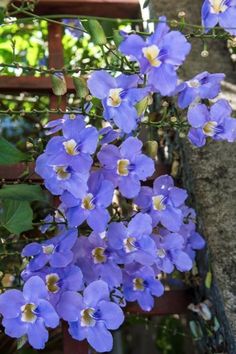
Nourishment
Thunbergia plants support healthy growth and flowering with regular feeding. During the growing season (spring and summer), a balanced water-soluble fertilizer can be applied every 2 to 4 weeks according to the manufacturer's instructions. Look for a fertilizer with a balanced ratio of nitrogen, phosphorus, and potassium (such as 10-10-10 or 20-20-20) to promote overall plant health and flower production. Please be careful not to apply too much fertilizer as this may cause the leaves to grow too long and make it difficult for flowers to bloom. Stop fertilizing in late summer to allow the plants to prepare for dormancy.
Issues
Although Thunbergia plants are relatively easy to care for, they may be prone to a few problems:1. *Pests:* The most common that can affect Thunbergia plants. Pests include aphids, spider mites, and whiteflies. Inspect your plants regularly for signs of infestation, including: B. If leaves turn yellow or growth becomes distorted, treat with insecticidal soap or neem oil as needed.2. *Diseases:* Thunbergia plants may be susceptible to fungal diseases such as powdery mildew and leaf spot. To prevent these diseases, ensure good air circulation around the plant and avoid overhead watering. If a fungal problem occurs, treat it with a fungicide spray according to the manufacturer's instructions.
What are the benefits of Thunbergia plants?
Thunbergia plants offer several aesthetic and practical benefits to gardens and landscapes.*Attractive Flowers:* Thunbergia plants produce colorful trumpet-shaped flowers that add beauty and visual interest to gardens and landscapes. Flower colors vary from yellow, orange, white, and sometimes blue and purple. *Attractiveness to pollinators:* Thunbergia plant flowers are attractive to pollinators such as bees and butterflies, helping to support local ecosystems and biodiversity.*Vertical Interest:* Thunbergia plants are climbing and can be trained to climb structures such as trellises, fences, and arbors, adding vertical interest to gardens and landscapes.. *Fast-Growing:* Thunbergia plants are fast-growing and quickly fill empty spaces in gardens and landscapes, providing a lush backdrop or privacy screen.. *Low Maintenance:* Thunbergia plants are relatively easy to care for and tolerate a variety of soil conditions. If managed properly, it can grow with minimal attention.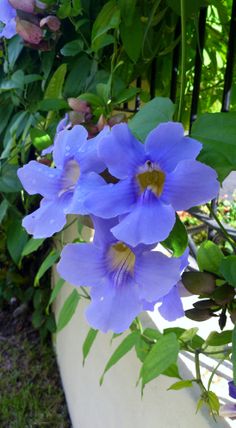
Frequently asked questions about growing Thunbergia plants?
How do you care for your Thunbergia?
To care for your Thunbergia plant and keep it healthy and flowering, follow these guidelines:
1. *Water:* Thunbergia plants are especially Regular watering is required during hot and dry periods. Water the plant when the top of the soil feels dry and avoid overwatering, which can cause root rot.
2. *Sunlight:* Thunbergia plants grow in full sun to partial shade. For optimal growth and flowering, ensure at least 6 hours of sunlight per day.
3. *Fertilization:* Feed Thunbergia plants regularly with a balanced water-soluble fertilizer during the growing season (spring and summer) to promote healthy growth and flowering. Follow the manufacturer's instructions for application amount.
4. *Pruning:* Prune Thunbergia plants as needed to control size and shape. Remove dead or damaged growth and cut back stems that are too long for fuller growth and more flowers.
5. *Support:* Provides support to climbing Thunbergia plants. B. Install a trellis or fence to allow climbing and vertical growth.
What is the Thunbergia plant used for?
The Thunbergia plant has a variety of uses, both ornamental and practical.
1. *Garden and Landscape Decoration:* Thunbergia plants are often used in gardens and landscapes because of their attractive flowers and ability to climb structures that add beauty and vertical interest. To the outdoor space.
2. *Hanging Baskets and Containers:* Some varieties of Thunbergia. Plants such as Thunbergia alata are popular for balconies, patios and other small spaces because they are suitable for growing in hanging baskets or containers.
3. *Groundcovers:* Low-growing Thunbergia varieties, such as Thunbergia fragrance, can be used as groundcovers in garden beds and along borders, forming carpets of green foliage and occasional flowers.
4. *Attracts pollinators:* Thunbergia flowers are attractive to bees, butterflies, and other pollinators, making them a valuable addition to gardens that want to support local wildlife.
Can Thunbergia plants be grown indoors?
Thunbergia plants are usually grown outdoors as they need plenty of sunlight to grow and produce lots of flowers. cultivated in gardens and landscapes. However, some varieties, such as Thunbergia alata, can be grown indoors as houseplants under the right conditions.
1. *Light:* Thunbergia plants grown indoors require bright, indirect sunlight. Place it near a south or west-facing window that receives at least six hours of sunlight per day.
2. *Temperature:* Thunbergia plants prefer warm temperatures between 18 and 29 °C. Avoid placing it near drafts or heating vents, as sudden temperature changes can stress the plant.
3. *Humidity:* Thunbergia plants prefer medium to high humidity. Increase humidity by placing a humidifier near the plant or placing the plant on a tray with pebbles and water.
4. *Water:* Water your Thunbergia plant when the top inch of soil feels dry. Avoid overwatering, which can cause root rot.
Which pot is best to grow a Thunbergia plant?
When choosing a pot to grow a Thunbergia plant, consider the following factors:
1. *Size:* Choose a pot large enough to accommodate the plant's root system. Thunbergia plants have relatively shallow root systems, so a pot that is wider than deep is ideal.
2. *Drainage:* Make sure the pot has proper drainage holes to drain excess water. Thunbergia plants are susceptible to root rot if the soil becomes waterlogged. Therefore, good drainage is essential.
3. *Material:* Choose pots made of porous materials such as clay or terracotta, which allow good air circulation to the roots. These materials also help drain excess moisture from the soil.
4. *Weight:* Consider the weight of the pot, especially if you plan on moving it often. For easier handling, lightweight plastic or resin pots may be suitable.
5. *Appearance:* Choose a pot that matches the aesthetics of your interior. Thunbergia plants are attractive and can catch the eye. Therefore, choose a pot that enhances its beauty.
Overall, the best pots to grow Thunbergia plants indoors are those that provide sufficient space for root growth, good drainage, and are made of materials suitable for optimal plant health.
Where can I buy Thunbergia plants?
Thunbergia plants can be purchased in a variety of places, including:
1. *Local Nursery:* Visit your local nursery or garden center to see if they carry Thunbergia plants. There are many different Thunbergia species and varieties available for purchase.
2. *Online Nurseries:* Many online nurseries and garden centers sell Thunbergia plants and can have them delivered directly to your home. Be sure to choose a reputable online seller with positive reviews.
